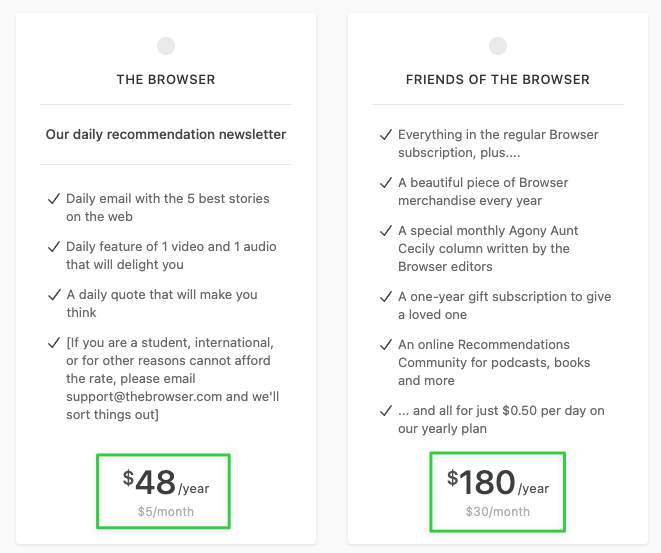Pricing your offers: Conversion vs retention
As your business evolves, your discount strategy should too.
In the previous article, Proven discount strategies for publishers, you learned the basic principles of setting up an offer for your email newsletter, from choosing a sound marketing goal to communicating your discounts effectively.

As your audience and revenue continue to grow, you may need more advanced material to help you reach the next growth milestone.
This resource dives into the specifics of using conversion and retention offers to accelerate your already growing publication.
Why conversion and retention can be competing goals
In the book The 22 Immutable Laws of Marketing, Al Ries and Jack Trout discuss the topic of discounting in their chapter The Law of Perspective.
They write,
“[In marketing], the long-term effects are often the exact opposite of the short-term effects.”
Simply put, conversion is a short-term goal, while retention is a long-term goal. Conversion focuses on how many people and dollars are coming through the door right now? While retention asks how long do our customers stay and which of them stay the longest?
Both are needed for a successful, sustainable subscription-based business. However, because they deal with different ends of the business, one will usually come at the expense of the other.
That’s why striking a balance between the two is essential.
When should publishers prioritize one over the other
Rather than an all-or-nothing approach, one should think about discounting strategy as a pendulum swinging back and forth between conversion and retention.
Conversion should be the focus when:
- A newsletter is brand new and has little to no audience. At this stage, the most important goal is to grow the initial fanbase.
- Short-term cash flow is a priority. Perhaps you want to grow your team or add additional value and an influx of signups could help you do that.
- You’re offering a new product or tier and want real customers to interact with it. Since the new item is untested, more conversions will help you get the information you need.
Retention should become the priority when:
- You want to reduce churn and smooth out the recurring revenue of your business.
- You need to increase the LTV of your customers, which can alter your marketing approach.
- The goal is to foster deeper relationships between you and your community.
Although the effects of these goals may differ, they're still complimentary — hence, why the most successful businesses use both.
Below, we’ll take a look at how to price each.
How to price for conversion
The most common type of conversion discount for newsletters is the introductory offer.
Introductory offers provide non-paying subscribers or visitors with a one-time discount. Newsletters use these to convert free audiences into paying members.
These are usually time-sensitive, steep discounts (e.g., 50% off today only).

The above example comes from The Information’s Creator Economy newsletter where non-paying subscribers can take advantage of a temporary 50% discount.
Introductory offers provide high conversion, low retention gains for a business:
- The deep discount and low initial price drives action with urgency.
- The low time commitment is attractive to people who may be on the fence (e.g., introductory offers are often applied to short, monthly subscription cycles, so people can easily leave if it's not what they were looking for).
Here are a few tips for pricing your introductory offer:
- Make the discount significant (e.g., 50% vs. 5% off).
- Keep the time horizon short (e.g., apply it to a monthly subscription rather than a quarterly or annual one).
- Imply urgency by using language such as for a limited time, setting an expiration date, or capping the number of customers who can take advantage of it.
How to price for retention
Retention offers aim to keep paying members engaged who are at risk of unsubscribing.
For example, many subscribers who purchased a conversion offer will unsubscribe once the discount is gone (usually in the first 1-3 months). Instead of potentially losing those paying customers, they could be given a special offer aimed at keeping them subscribed for longer.
As mentioned in the previous article, annual subscriptions are the gold standard for retention for a few reasons:
- They make excellent core offers because annual subscribers have higher LTVs.
- They churn less often and at a lower rate. If you consider that every payment reminds your customers of the cost, it makes sense that people who see fewer payments (1x per year vs. 12x per year) will unsubscribe less often.
- Annual customers are often more engaged with your work and, therefore, more likely to share with others, potentially growing your audience even further.
All that being said, annual subscribers are more difficult to acquire (lower conversion, higher retention) for two reasons:
- It costs more to pay for one year upfront than it does for a single month.
- A 365-day commitment is more intimidating than a 30-day one.
Still, the stability and longevity they bring to any business make the challenge worthwhile. Here are a few pricing tips to lure them in:
- Highlight the savings amount in relation to a monthly subscription. If an annual membership costs the same as paying individuals for 9, 6, or even 3 months — the psychology of that will push people to switch.

- Provide annual subscribers with benefits not available on monthly plans. This differentiated value proposition will help make pricing a smaller part of the decision-making process.
- Reward retention by increasing your prices at regular increments. Earlier supporters will pay less than later ones; and if they ever leave and return, they’ll lose their lower price advantage.
Better together
Conversion and retention are two halves of the offer puzzle. One helps you grow. The other, persist.
Together, these strategies will help you reach and surpass the milestones you're aiming for.







